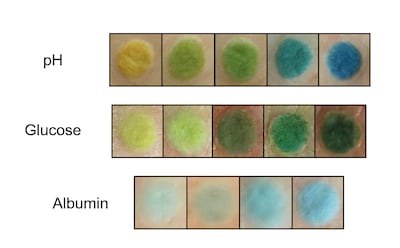We all know about wearable technology, and how those little watch-like thingies can tell you all about your heart rate, sleep patterns and the number of steps you take.

But what if the technology was on your skin? And what if it was fashionable as well?
“In our research, we replace traditional tattoo inks with functional materials, which can sense substances in the body,” says Dr Ali Yetisen, associate professor in the Department of Chemical Engineering at Imperial College London.
Tattoos may seem like a relatively recent fad, but humans have been decorating their bodies for thousands of years. “Tattoos have existed for centuries. Even the early cavemen used tattoos for therapeutic purposes,” says Yetisen. Now, by replacing conventional tattoo ink with special inks that act as sensors, your tattoo could still look cool while telling you a lot about your health.
READ MORE
Researchers developed inks that change colour when in contact with specific compounds in your blood: the sensor inks can detect changes in glucose (a type of sugar used by cells as fuel), pH (a measure of how acidic the blood is), and albumin (a protein in your blood made by your liver). Scientists then tested these special inks by tattooing bits of pig skin, which is very similar to human skin, and immersing these bits into fluids containing variable amounts of compounds.
The researchers were able to see the colours of the tattoo inks changing to reflect the contents of the fluids that the skin was floating in; taking pictures of the skin with a smartphone camera, they were able to use a special algorithm to measure the change in colour on the tattoo and correlate it with the amount of compound present on the fluids.
Dyes that change colour in response to changes in pH or glucose levels are widely known, especially in strips that doctors use for a quick snapshot urine test, for example. However, by tattooing permanent pigments into the skin, real-time monitoring of the levels of different compounds would be available for the first time, without the need for constant finger pricks or blood tests. Because a tattoo can have many colours, different sensor inks that monitor the levels of different compounds could be tattooed together, allowing for monitoring the levels of multiple compounds at the same time. This would be very useful, for example, in patients with diabetes, who need to check their glucose levels but are also at increased risk of acidosis (too much acid in their blood).
But how do tattoos know what’s happening in your blood? When you get a tattoo, a pigment is injected through the outer layer of your skin into the dermis, an elastic tissue that acts as a sort of scaffold, which your skin cells sit on. Skin cells are immersed in a fluid that constantly exchanges nutrients and other materials with our blood: that’s how cells get fed and then dump their waste products. Because this fluid that surrounds skin cells is in very close contact with our blood, its contents will reflect those of blood. For example, if there is an abundance of glucose in the blood, the fluid around skin cells will also have high levels of glucose. Wearable skin patches that measure components in the sweat have been developed, but sweat is not representative of the contents of the blood: sensor tattoo inks have the advantage of being in close contact with a fluid that closely reflects the contents of the blood.
Another advantage of having these sensors tattooed is that, of course, tattoos are permanent. Incidentally, this permanency arises from never-ending digestive issues: when the pigment particles are injected into the skin, they are promptly eaten by white blood cells that have taken residence in the area. These white blood cells are part of our immune system, and generally eat, then digest anything they find suspicious, like bacteria.
However, unlike bacteria, pigment particles cannot be broken down and digested, and the white blood cell keeps them inside unchanged. When it dies, the contents of the cell are released, and the pigment particles are eaten by another white blood cell doing the rounds. Tattoo pigments can go through several cycles of being eaten, released, eaten by white blood cells, and the whole time the appearance of the tattoo doesn’t change. Mad, isn’t it?

The new dyes developed for these tattoos did not appear to be toxic to the skin, but more research is needed to find out whether they could be targeted by the immune system as potential enemies. Researchers also plan to expand the development of these sensor inks to monitor the levels of more compounds such as sodium, cortisol (a marker of our body’s stress response) and even oxygen.
“The applications of these tattoos are in wellness monitoring and disease monitoring. For example, measuring electrolytes is useful in determining the dehydration status of an athlete. We can measure hormones for stress monitoring. Similarly, such tattoos can be used to determine kidney and liver function or toxicity in the body,” says Yetisen.
Dr Aoife Morrin, associate professor at the School of Chemical Sciences and director of the National Centre for Sensor Research at Dublin City University, says: “This is hugely innovative, leveraging the ancient art of tattooing for benefiting modern medicine. Bringing this to in vivo would be a game-changer. It is not without its challenges, but the potential for empowering us to better monitor and manage our own health would be profound.”













